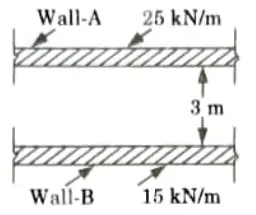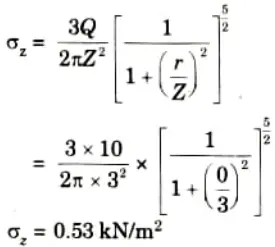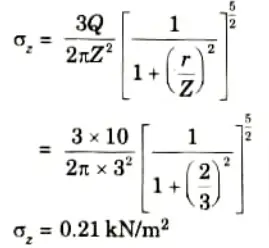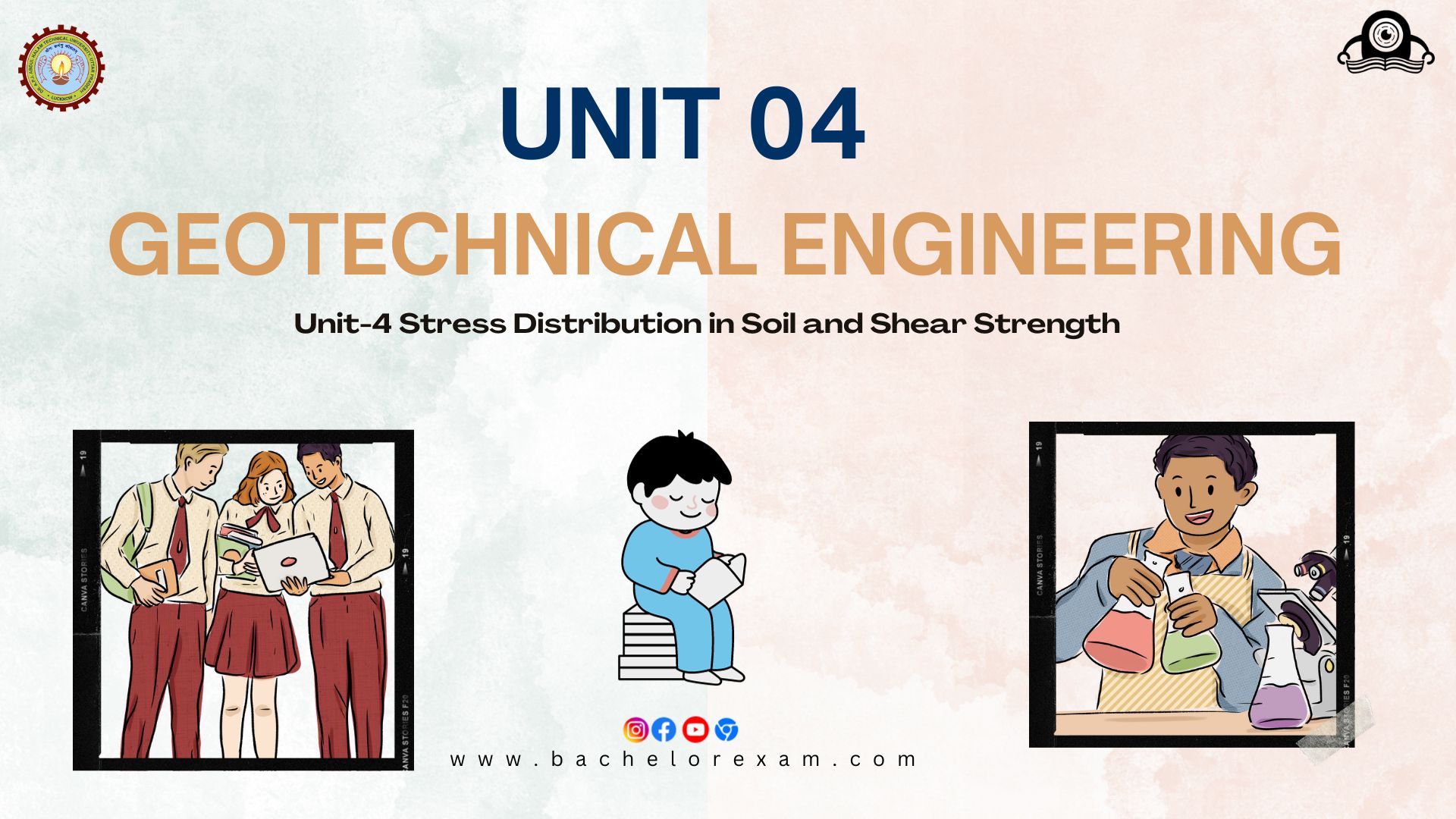Aktu Btech Quantum Notes will help you prepare for your Geotechnical Engineering test. These vital, frequently asked questions and detailed materials will put you on the right track. Improve your education today! Unit-4 Stress Distribution in Soil and Shear Strength
Dudes 🤔.. You want more useful details regarding this subject. Please keep in mind this as well. Important Questions For Geotechnical Engineering: *Quantum *B.tech-Syllabus *Circulars *B.tech AKTU RESULT * Btech 3rd Year * Aktu Solved Question Paper
Q1. Two long boundary walls of small width run parallel to each other at a distance of 3 m apart. The self weights of the walls are 25 kN/m and 15 kN/m. Plot the distribution of vertical stress intensity due to the walls on a horizontal plane 3m below the ground level.
Ans. Given: Self weight of walls 25 kN/m and 15 kN/m
Distance between walls = 3 m, Depth of plane = 3 m
To Find: Stress distribution.
1. Vertical stress due to line load at ‘Z’’ in depth from the ground level.



2. Vertical stress due to wall-A at 3 m depth from the ground level,



3. Vertical stress due to wall-B at 3 m depth from the ground level,



4. Vertical Stress Due to Wall-A:
i. At point A, x = 0, Z =3 m









6. Stress Distribution:



Q2. Describe direct shear test. What are its merits and demerits ?
Ans. Direct Shear Test:
- 1. To determine the shear strength characteristics of soil or rock material, geotechnical engineers conduct direct shear tests in laboratories or on the job sites.
- 2. The shear box is the original type of instrument for applying shear force directly.
- 3. As shown in Fig. the apparatus consists of a square brass box that is horizontally split at the level of the soil sample, and it is kept in place by metal grilles and porous stones.
- 4. A steady vertical load is applied to the sample and maintained during the test.
- 5. The lower portion of the box is subjected to a horizontal load that gradually increases until the sample fails in shear.
- 6. The shear load at failure is divided by the cross-sectional area of the sample to give the ultimate shearing strength.
- 7. The vertical load divided by the area of the sample gives the applied vertical stress 𝝈.
- 8. A proving ring is fitted to the upper half of the box to measure the shear force. As the box moves, the proving ring records the shear force.
Merits: Following are the merits of direct shear test:
- 1. Direct shear machines are easy and quick to use.
- 2. Direct shear requirements are significantly less expensive than other testing.
- 3. Sands and gravels are simple to test.
- 4. Because tiny samples can produce inaccurate results, bigger samples can be evaluated in large shear boxes.
Demerits: Following are the demerits of direct shear test:
- 1. The normal and shear stress distribution along the intended failure plane is extremely complicated.
- 2. Since a saturated soil’s water content varies quickly under stress, the drainage situation during this test cannot be controlled.
- 3. During the direct shear test, the area of the failure plane is not constant. This area will be less than the soil specimen’s initial area.
- 4. A preset horizontal plane is used to shear the soil. Not necessarily the weakest plane is this pushed plane. This is the direct shear test’s most significant drawback.
- 5. The results are likely to be impacted by the internal restraint caused by the shear box’s side walls.
- 6. It is impossible to measure the pressure of pore water.
Q3. Describe the unconfined compression test ? What is its advantage over a triaxial test?
Ans. Unconfined Compression Test:
- 1. A triaxial test is a specific instance of an unconfined compression or uniaxial compression test.
- 2. A cohesive soil cylindrical specimen is subjected to the unconfined compression test to determine its unconfined compression strength.
- 3. The test technique is made simpler by the absence of confining pressure and the need for the triaxial cell construction.
- 4. It is done on specimens of saturated clay that can stand alone.
- 5. The clay specimen is axially loaded, increasing the force till failure. The loading process moves rather swiftly.
- 6. A stress-strain plot and the unconfined compressive strength are produced by taking periodic measurements of the specimen’s axial shortening and the applied load.
- 7. This approach is easier but less trustworthy.
Advantages of unconfined compression test over triaxial test:
- i. The exam is straightforward, quick, and convenient.
- ii. It is appropriate for determining the saturated clays’ unconsolidated-undrained shear strength.
- iii. The test can be easily used to determine the soil’s sensitivity by first using an undisturbed sample and then a remoulded sample.
Q4. What are the advantages and disadvantages of triaxial compression test?
Ans. Advantages: Following are the various advantages of triaxial compression test:
- 1. The drainage conditions are completely under control. For each of the three categories of drainage problems, tests are simple to run.
- 2. It is possible to measure directly both volumetric changes and changes in pore pressure.
- 3. The failure plane’s stress distribution is uniform.
- 4. Failure of the specimen is permitted on the weakest plane.
- 5. It is known what the stress level is at each intermediate stage and at failure. Any stage of shear can be used to draw the Mohr circle.
- 6. The test is appropriate for precise study.
Disadvantages: Following are the disadvantages of triaxial compression test:
- 1. The apparatus is complex, expensive, and large.
- 2. In comparison to a direct shear test, the drained test requires more time.
- 3. The assumption that the specimen will remain cylindrical does not hold up well at enormous strains, making it impossible to precisely calculate the cross-sectional area of the specimen.
- 4. Only axis-symmetrical situations are simulated in the test. In the real world, problems are typically three dimensional. It would be more beneficial to conduct a generic test in which the three stresses are altered.
- 5. The consolidation of the test specimen is isotropic, whereas the consolidation in the field is typically anisotropic.
Q5. A water tank is supported by a ring foundation having outer diameter of 8 m and inner diameter of 6 m. The uniform load intensity on the foundation is 200 kN/m2. Compute the vertical stress caused by the water tank at a depth of 4 m below the center of the foundation.
Ans. Given: Intensity of UDL = 200 kN/m2, Z=4m, Do = 8 m, Di = 6 m
To Find: Vertical stress.
1. Boussinesq equation for uniform load on circular area is applicable to finding vertical stress under a wholly loaded circular area has been extended to such cases where the entire circular area is not loaded and only a ring portion is loaded between radius Ro and Ri as shown in Fig.






Q6. A concentrated load 10 kN acts on the surface of a soil mass. Using Boussinesq analysis, find the vertical stress at points
(i) 3 m below the surface on the axis of londing, and
(ii) at radial distance of 2 m from axis of loading and at depth of 3m.
Ans. Given: Concentrated load, Q= 10 kN, Depth of point, Z = 3 m
Radial distance of point, r = 0
To Find: Vertical stresses.
1. Using Boussinesq equation:
Vertical stress at point 3 m below the surface,



2. Stress at radial distance of 2 m from axis of loading and at depth of 3 m is given by:






Important Question with solutions | AKTU Quantums | Syllabus | Short Questions
Geotechnical Engineering Btech Quantum PDF, Syllabus, Important Questions
| Label | Link |
|---|---|
| Subject Syllabus | Syllabus |
| Short Questions | Short-question |
| Question paper – 2021-22 | 2021-22 |
Geotechnical Engineering Quantum PDF | AKTU Quantum PDF:
| Quantum Series | Links |
| Quantum -2022-23 | 2022-23 |
AKTU Important Links | Btech Syllabus
| Link Name | Links |
|---|---|
| Btech AKTU Circulars | Links |
| Btech AKTU Syllabus | Links |
| Btech AKTU Student Dashboard | Student Dashboard |
| AKTU RESULT (One VIew) | Student Result |
